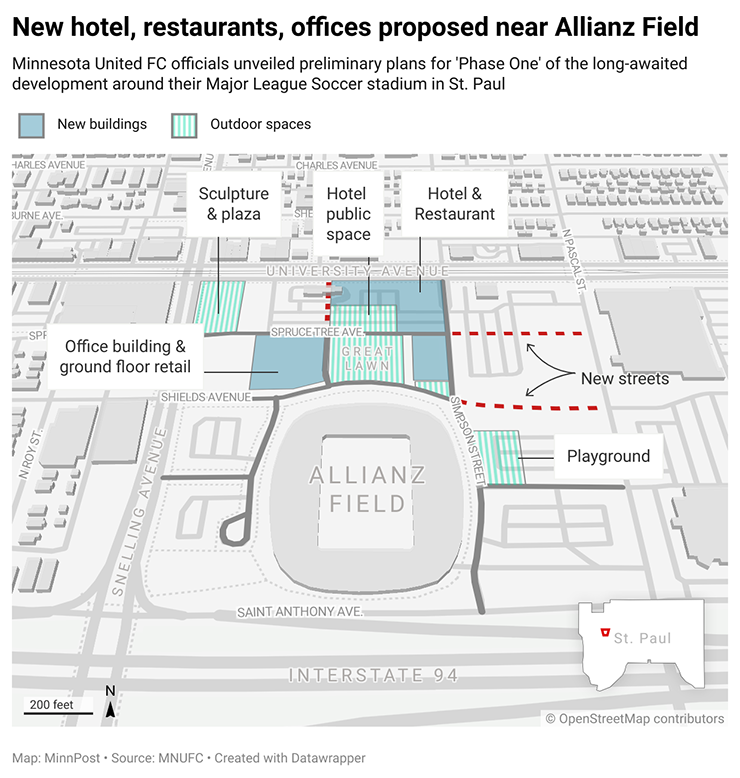Seven years ago, Minnesota United FC (MNUFC) won permission to build in St. Paul’s Midway neighborhood, not only a Major League Soccer stadium, but also to surround that stadium with retail space, high-rise office buildings, housing and a hotel.
Then – less than a year after Allianz Field hosted its first match – the COVID-19 pandemic hit and region-wide civil unrest followed, leaving neighbors to wonder when the promised development would begin on the fenced-off lots around the stadium.
Now, after years of quiet, there are signs of action again.
MNUFC owner Dr. Bill McGuire recently unveiled preliminary plans for a new hotel, office building, playground, sculpture plazas, retail spaces and restaurants at Snelling & University avenues – the first phase, he said, of the “United Village” development around the soccer stadium. Construction could begin by spring or summer of next year.
Team officials and city leaders saw the stadium development as a means of injecting new vitality into the neighborhood long before many of its storefronts were damaged during the 2020 unrest. In some ways, the newly-released concepts show how the pandemic has tempered MNUFC’s ambitions for the site.
Still, the sign of progress offers some hope to neighbors that their concerns about accumulating delays – and trash – at the site might soon be addressed.

At an Aug. 17 meeting hosted by St. Paul officials, including local St. Paul City Council Member Mitra Jalali (Ward 4) and two neighborhood groups, McGuire presented new renderings and answered questions for the proposed additions to the 34-acre site:
- Full-service hotel: The hotel would have 158 rooms and also include a bar, restaurant, an attached parking garage and retail space on the ground floor. The building would be located between University Avenue and an existing grass-filled space north of the stadium known as the Great Lawn. The southeast corner of the building would also include a public restroom.
- Office building: At 100,000 square feet, the four-story office-building proposed for the northwest corner of the stadium is roughly one-third the square footage of any of the high-rises envisioned in the site’s 2016 master plan – a reflection of the rise of remote work and a difficult market for office space. McGuire said odds are “pretty good” that MNUFC would relocate from its current Golden Valley headquarters to this new building, and he said “two or more” other tenants are lined up. The ground floor would contain an underground parking level, retail square footage and space for a bakery and coffee roaster. The surface parking lot on the neighboring plat could host farmers’ market-style events until it’s developed, too.
- Restaurant pavilion: South of the hotel and across the Great Lawn from the office building, preliminary plans call for another restaurant. Concept drawings called for lots of outdoor seating, large glass windows and a casual atmosphere.
- Outdoor amenities: The St. Paul Park Board has already considered the team’s application to create two park spaces – a sculpture plaza at the corner of Snelling and University, and an accessible playground to the east of the stadium that’s designed to be accessible for children who need to use wheelchairs or other mobility devices. If the council ultimately approves the parkland dedication, the privately-owned site would need to remain as accessible as a public park in perpetuity.
These additions are just the first steps in developing the land around the stadium. Even if this first phase is completed, plans show that roughly one-quarter of the 34-acre site will remain open for future development.
At the Aug. 17 meeting, neighbors peppered McGuire with questions about trash and litter that collects along fences erected before the pandemic, especially along University Avenue.

Another person who spoke at the meeting, who didn’t give his name, wondered whether new development would help, since trash has been an issue “since the very beginning.”
McGuire said that, for the time being, the fence line that’s gathering trash is on parts of the superblock that are owned by another New York-based company. When construction starts, he said, ownership of the land – and responsibility for maintaining it – will transfer to him, and that could offer a remedy from the trash problems.
Other neighbors asked why new housing wasn’t included in plans for the first phase of development. McGuire said the team does plan to build new housing in future phases, but that he wanted to avoid “just popping down houses without creating a community or a village” to make people feel at home.

“You create a place that people really say, ‘Hey, look what all I got,’” McGuire said. “‘I’ve got a playground for my kids, shops right across the street – I can live here.’”
McGuire took prepared questions for more than an hour and committed to remain involved and engaged with neighbors’ concerns.
“I will stand by my commitment to what you’ve seen,” McGuire said. “But if you find it’s time to have a bitch, we can do it. I’m always around.”
The St. Paul City Council will need to vote on new platting for the site as well as interim use permits in September, and environmental remediation work will continue through the fall.


0 Commentaires